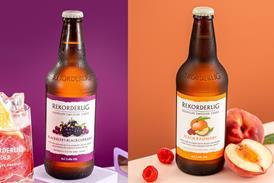It’s all about health, convenience and bold flavours in the snacking aisles at the moment and there’s an obscene amount of product choice for retailers. So what’s trending and what’s not?
Whether we’re demolishing a packet of salt ‘n’ vinegar on the way to work, or noshing a cheeky sausage roll on the school run, the UK is definitely a nation of super-snackers.
Research reveals that a whopping 96% of people eat snacks, with 69% snacking at least once every day (Mintel 2018).
Snacking’s impulse and on-the-go nature helps make it a hero category for c-stores. In fact, snacks are the second most popular food-to-go choice in the channel, beaten only by soft drinks.
With this in mind, it makes sense to get the category on-point in-store. This is especially true if you’re next to a busy Colchester bus station that attracts hungry bus drivers and travellers from 5.30am in the morning, like Geoff Sharp, co-owner of Save Local in Colchester.
“Snacks are a very big thing for us just because of where we are,” he says. “It’s impulsive. People want a packet of crisps and something else to eat and it has to be really quick and easy for them, because they might only have 30 seconds to get what they want before the next bus.”
In this time-pressured situation it’s all about directing their impulse. And according to HIM, food-to-go customers are getting even more impulsive as time goes on. In 2017, 42% of food-to-go shoppers bought a product impulsively, up from just 19% in 2015.
To harness this now-factor, Geoff is aiming to merchandise crisps more strategically around the store.
“When we had crisps under the counter we were doing about 20 boxes a week. I reckon [now] we could be doing 120 boxes a week,” he says.
“What I’ve done is put all the £1 crisps down one side of the store as people walk in, and then the rest down the other side. So far I’m up to about 80 boxes a week, so not bad.
“Customers want you to make it really easy for them to get what they want. They want to walk in, pass it and pick it up.”
Geoff adds that having a great selection also boosts basket spend by encouraging customers to make multiple purchases. “If you have a good selection of crisps they don’t just pick up one packet, they’ll take three or four different packets.”
Not all retailers are next to such high-footfall areas. But to maximise sales, it still pays to have a think about how snacks are merchandised at your store.
“I think the key is trying to navigate customers around the deals that we have in the shop,” explains Sam Coldbeck, from Wharfedale Premier in Hull.
“We try to tie things together. For instance, we merchandise the snacks along with the beers for the Big Night In occasion alongside the ice cream chiller, which works really well.”
Meal deals can also be a big driver for snack sales. Figures from HIM show that meal deals can inspire 26,000 more sales per store and that 63% of customers prefer a three-item meal deal that includes some kind of snack.
Sam also offers a meal deal, which is a big hit with the workmen busy on the construction sites near her store. She says that the meal deal has also helped promote lines which previously hadn’t flown with her regular customers.
“We offer healthier options such as the Walker’s Baked crisps,” she says. “To be honest, in the past they didn’t sell so well. But now that they’re part of the meal deal, and people can get them as part of their lunch in a format where they’re getting value for money, they do so much better.”
Thomas Magennis, manager of Eurospar Mulkerns in Newry, has also seen how repositioning snacks can drive sales. He made the move to increase space devoted to crisps to include more healthy baked options and saw sales rise by an impressive 40%.
“I put this down to the fact that we started zone merchandising the store,” he says. “We put all the sandwiches, crisps and soft drinks together, which encouraged much more impulse purchasing of crisps from shoppers buying sandwiches.”
When it comes to working out in-store deals and zoning, it’s not just all about the crisps. Some 39% of food-to-go shoppers would also like nuts included as a healthy snack option.
“I’m not sure that nuts are really that much healthier than a packet of crisps,” says Anita Nye from Premier Eldred Drive Stores in Orpington, Kent. “But whatever people think, right now I’m finding that customers are really into nuts – they’re a big seller for us. It’s not just standard peanuts either, it’s lines such as pistachios and cashews.”
In part, Anita puts this down to the rise in people staying in with friends rather than going out to socialise in pubs. She also says that the Big Night In trend helps sales of the bigger bags.
“I think that a lot of people today stay at home rather than go to the pub,” she says.
“They generally pick up nuts in larger quantities and bigger bags. They’ll buy a few and save some for later so there’s a big emphasis on the sharing bags. I think it’s that thing of people going to the pub, ordering a pint and then getting a bag of nuts to have with it. And people want that same kind of thing at home if they’re having a barbecue, watching sport or whatever.”
Nuts are a key part of the sales mix for c-stores everywhere. But the breadth of selection depends on the tastes of local snack-seeking customers.
Matt Hutchinson, branch manager for Select Convenience and Post Office in Bents Green, Sheffield, says that the city’s shoppers tend to have high-end tastes. Yet that doesn’t necessarily extend to nuts.
“To be honest we used to sell quite a big range, with yogurt-covered nuts and things like that, but we’ve reduced that right down. Apart from the KP nuts I’d say that we’re not a nutty area in general (although I guarantee that we’re nutty in lots of other ways).
“It does change at Christmas for us, though. That’s the time when people seem to really want nuts.”
So what snacks float customers’ boats up in Sheffield? Being proud Yorkshire-people, locally-produced crisps are a big hit.
“Stocking local snacks works really well for us,” says Matt. “People like the idea that what they’re eating was produced not that far from our store.”
“We stock crisps from two local companies: Yorkshire Crisps and Pipers (who are not as local but they’re Yorkshire, and that’s good enough for us). They do sell well, and they’re not cheap either – about £1.99 for a big bag. The barbecue season is really helping sales at the moment.”
As provenance continues to chime with customers, many retailers would like to follow Matt’s lead. Enterprise Foods works with more than 400 suppliers across the UK to try to connect more suppliers with stores, enabling them to boost their local offering.
These suppliers include Snaffling Pig, which produces pork crackling, rind and scratchings, plus hot sauce.
“With shoppers becoming more adventurous in their choices, we’re now seeing an increase in demand for alternatives to traditional potato crisps, including pork scratchings, pitta chips, chickpea-based products, and assorted vegetable crisps including sweet potato, carrot and beetroot,” says Nikki Habershon, marketing and category controller at Enterprise Foods.
“This is where local suppliers really come into their own, with plenty of artisan options from local producers offering a point of difference versus traditional snacks.”
Habershon also points out that for health-conscious consumers, buying local can also give them reassurance on the quality of ingredients used. She adds that many local producers are happy to provide sampling sessions in-store to give shoppers the chance to try before they buy.
Popping up
Popcorn is a snack that also earns its place on the shelves, especially towards the weekend. “We sell a lot of popcorn,” agrees Matt.
“Our biggest seller is Butterkist, in all the different flavours. That’s definitely a weekend thing, and I think people get it to accompany a film or when they’re watching TV. Kids buy it all the time, though. They don’t mind what day of the week it is.”
Generally, Matt believes that there’s a big desire out there for something new. He thinks customers are always ready to have their heads turned by something fresh and exciting in snacking.
“I’m feeling that people are getting a bit sick of the same old flavours and brands – they want something different,” he says.
This drive for something new is a large part of the fast-moving snack sector. Sam says that the key is introducing new lines (often on promotion) to add interest while ensuring that all the old favourites are fully accounted for.
“At the minute we’re doing the Walkers world flavours which are doing well on promotion,” she says.
“It’s getting the balance right between old and new. The new flavours create sales, then we’ve got our core range which never changes, and which people love.
“I find that our customers are very traditional and they know what they like. If something new comes out then they’ll want to try, but then go back to their old ways. It’s like with the pulled pork popcorn. People tried them once, and then we got a lot of stock almost going out of date.”
What is changing is the emphasis on value. According to HIM, price is the most important factor in choosing snacks (valued by 85% of food-to-go customers), followed by brand (75%) and pack size (72%). Sam says that stocking multipacks is a canny way to balance these different touch-points.
“I think that people are looking for bigger packs and better prices,” she says.
“Our multipack sales, such as our 36-pack Walkers, are selling really well. I think, more than ever this year, people are comparing prices at c-stores with the multiples. That’s terrifying. But with Booker we’re able to offer the same kind of prices.
“I also think that people are more used to shopping in volume now. They don’t do the big shop anymore, but if they buy a multipack they’ll get more variety in the pack and it’s not going to go out of date in three days.”
Permissable treats
New fads and flavours come and go, but crisps, nuts and popcorn are going to be the core c-store offer for some time to come. However, though the key products may stay the same, the way customers perceive them has definitely changed.
Where once snacks were seen as harmless everyday treats, the spectre of obesity means that the government is advising caution when chomping down on the savoury snacks. In fact, Public Health England’s latest project is advising parents to limit kids’ intake to two 100-calorie snacks a day.
If successful, this could have serious consequences on the future generation’s eating habits.
All of the c-store retailers we spoke to in this feature were keen to stock healthier snacks, whether that meant baked crisps, protein bars or fruit. Yet Matt believes that, in the adult snacking market at least, customer choice is always going to win out against well-meaning advice. “Whatever the government says, it’s all down to what people want to buy. And that’s an essential part of being a good convenience store.”
So while more healthy-looking snacks, such as nuts and baked or popped crisps, are definitely more popular than in the past, it’s essential to keep the traditional options as well.
The impulsivity of snacking makes its success very dependent on the way it is merchandised so make sure it’s easy to grab on its own, as well as part of a meal deal and Big Night In selection.





![PLAUK0125 Jacobs The Trussell Trust Portrait[53]](https://d2dyh47stel7w4.cloudfront.net/Pictures/274x183/6/4/1/322641_plauk0125jacobsthetrusselltrustportrait53_125111_crop.jpg)















No comments yet